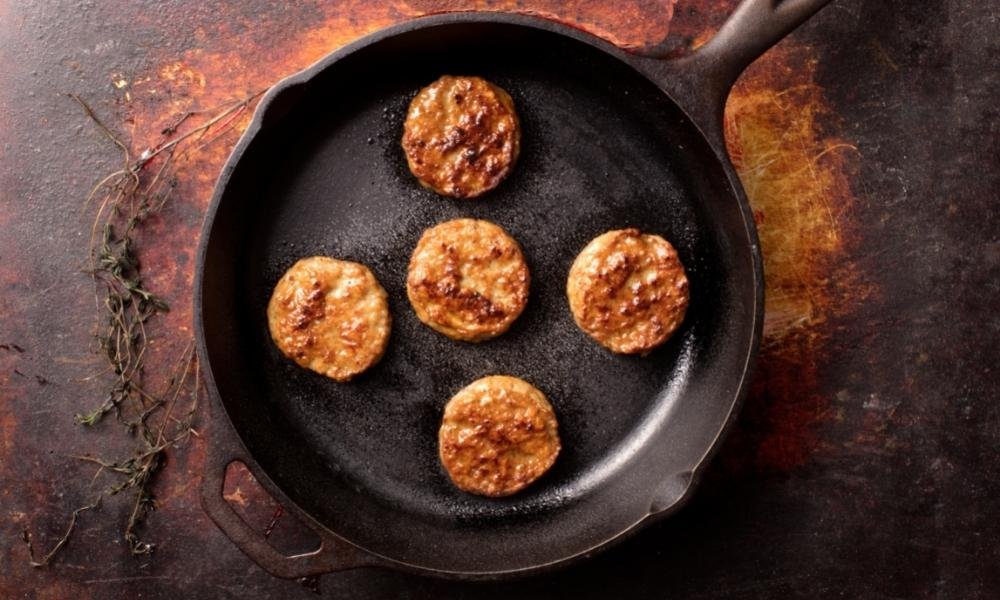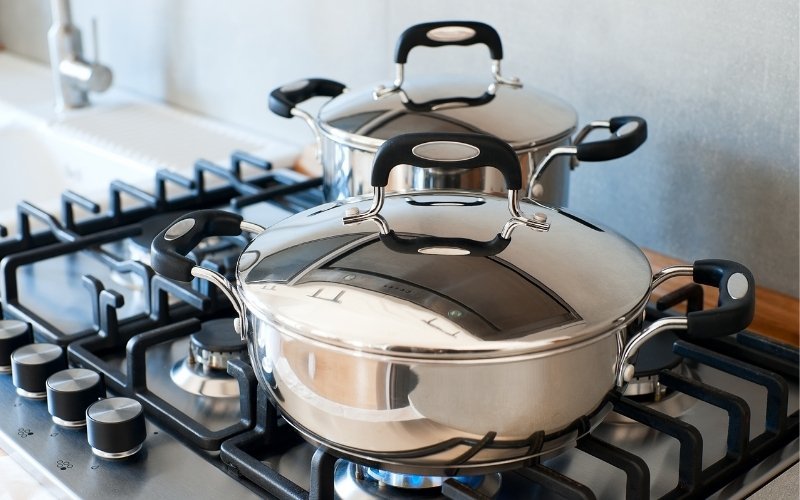Cast iron and stainless steel are some of the safer cookware materials that are gaining popularity in India. They both have their own advantages and disadvantages which may confuse you when choosing the right one for your needs. So, we compare various aspects like safety, stick resistance, durability and maintenance of cast iron and stainless steel cookware to help you make an informed choice.
Health and Safety
Cast iron, as you may know, is one of the best healthy cookware materials available in India. These cookware are made predominantly of iron and also have a small percentage of carbon and silicon in them. When cooking in them, food gets fortified with iron. Thus, it improves your daily iron intake.

According to research, iron leaches at a higher rate in acidic food, because it breaks down the seasoning and the food gets in contact with the iron underneath. But dry, non-acidic food doesn’t get significantly fortified with iron. Also, a thick layer of seasoning hampers the transfer of iron. But then, without proper seasoning, food gets stuck in cast iron cookware too. So, it is a catch-22 situation.
Stainless steel comes in different grades. Out of the various options, triply stainless steel cookware are the best because they offer better heat conduction and are highly durable. Though they are considered safe, people with a nickel allergy should avoid stainless steel because it leaches nickel into the food. Acidic food especially should be avoided during the first 10-15 cooking cycles. But, after that, the quantity of nickel and chromium leached into food is very minimal and within FDA limits. Alternatively, you can opt for nickel-free stainless steel cookware from Meyer.
Winner- Cast Iron
Heat Conduction
Contrary to popular belief, cast iron does not conduct heat uniformly. So, if you fry fish in a cast iron Tawa, you will often notice that the ones at the edges are not as brown as the ones at the centre. But, it retains the heat much longer due to high thermal resistance. So, if you preheat the cast iron pan on a low flame for 5-10 minutes, you will be able to achieve good searing on everything you fry.

A triply stainless steel pan on the other hand conducts heat evenly, thanks to the layer of aluminium sandwiched in between. When you spread a thin layer of flour on a stainless steel pan, you find that the flour browns evenly from edge to edge. This is because of the high thermal conductivity of triply stainless steel.
Winner- Stainless Steel
You may also like: 7 Best Pressure Cookers In India
Stick Resistance
Cast iron develops a thick layer of seasoning with constant use. This layer which has a slick finish improves the stick resistance of cast iron cookware. You will never be able to achieve stick resistance like a Teflon pan. But, with sufficient oil, you can cook without worrying about food getting stuck on the cast iron pan.

When cooking on stainless steel, you need to preheat it sufficiently, pour oil and wait for it to glisten. Else, food may get stuck on the pan. If you are using stainless steel for the first time, you may find it a bit frustrating till you get the knack. Comparatively triply stainless steel pans are easier to manage as they have a thick base. But, disc-bottom and single-ply stainless steel pans are more prone to scorching.
Winner- Cast Iron
Durability
I use a cast iron Kadai which was handed down by my MIL. She used it for about 30 years before giving it to me. Cast iron cookware is incredibly durable that you can pass it on as a family heirloom. In fact, the older it gets, the better it becomes. It is almost indestructible unless it falls down from a height and cracks. Once cracked, you can’t weld it.

Triply stainless steel cookware are also quite durable. They last for decades with proper care. However, poor-quality stainless steel pans can warp. So, you need to take proper care and avoid overheating them.
Winner- Cast Iron
Ease of Handling
Cast iron cookware are thicker and hence weigh a lot more compared to triply stainless steel cookware of similar capacity. As a result, it is a lot more difficult to handle. It is quite difficult to toss food using a cast-iron skillet, but pretty much possible using a stainless steel pan. Similarly, a 5-litre biriyani pot made of stainless steel is easy to move and handle. But a 5-litre cast iron dutch oven takes serious muscle strength to move around.

Also, you will notice that handles of cast iron cookware are moulded together. In stainless steel, the handles are attached using rivets. As a result, handles of stainless steel cookware are comparatively less hot than cast iron.
Winner- Stainless Steel
Maintenance
One of the biggest disadvantages of cast iron is that they need frequent maintenance, or else its seasoning will flake off and the cookware will rust. So, you need to clean them immediately after use and then oil and store it away to prevent rusting. However, after a few years of use, cast iron would have developed a thicker layer of seasoning. At that point, it won’t need much maintenance measures.

Stainless steel, on the other hand, is almost maintenance-free. You can clean it like any other cookware and you needn’t worry about rusting or damaging it.
Winner- Stainless Steel
Ease of Cleaning
Cast iron cookware cannot be cleaned in a dishwasher as the strong chemicals and water spray will damage the seasoning. It has to be hand-washed with mild soap and soft scrub. As it has better stick resistance, food won’t get stubbornly stuck on them.

Stainless steel cookware can be cleaned in the dishwasher. But, often, food gets stubbornly stuck and you may need more elbow grease to clean it up.
Winner- Can’t say
Price
Triply stainless steel cookware are much more expensive than cast iron cookware. It costs at least Rs. 1500 for a triply stainless steel frying pan. Depending on the brand, type and size of the cookware, it may cost as much as Rs 4000 or more.
Cast iron cookware, on the other hand, are much more affordable. If you are confident about seasoning the cast iron cookware on your own, you can buy them for as little as Rs. 300 onwards from the local shop. Preseasoned cast iron Tawa and Kadai are available online and they are comparatively more expensive. But, they are preseasoned and have better finishing. So, at least the first few times, you needn’t worry about food getting stuck on them.
Our Recommendation
A combination of cast iron and stainless steel cookware is the best way to go. Cast iron would be ideal for Dosa Tawa, Kadai for stir-frying vegetables, deep frying, Appa Chatti and for making food that needs a nice searing. Stainless steel cookware is more apt for larger Kadais for curries, rice, Biriyani and such delicacies. They are also ideal as saucepans and frying pans.
Some of our top recommendations are Cast Iron Tawa from Dynamic cookware for making Dosa, Roti etc; small cast iron Kadai from Indus Valley; stainless steel Kadai from Stahl and stainless steel frying pan from Meyer.
